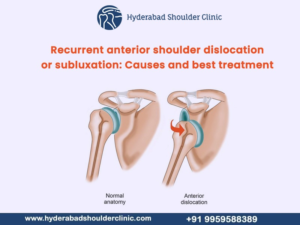A shoulder dislocation occurs when the head of the upper arm bone (humerus) pops out of the socket of the shoulder blade (scapula). This injury can happen due to various reasons, including falls, sports injuries, or trauma from accidents.
There are two main types of shoulder dislocations:
Anterior Dislocation: This is the most common type, where the humerus moves forward out of the socket. It often happens when the arm is extended and rotated.
Posterior Dislocation: This less common type occurs when the humerus moves backwards out of the socket, typically due to seizures or electric shocks.
Symptoms of shoulder dislocation can include severe pain, swelling, an inability to move the shoulder, and a noticeable deformity in the shoulder appearance.
What is a partial shoulder dislocation?

A partial shoulder dislocation, also known as a shoulder subluxation, occurs when the head of the humerus (the upper arm bone) slips partially out of the shoulder joint socket but does not completely dislocate. This can cause instability in the shoulder joint and may lead to pain, weakness, and a limited range of motion.
What are the causes of partial shoulder dislocation?

Partial dislocations can happen due to similar causes as full dislocations, such as trauma, overuse, or repetitive movements, often seen in athletes or individuals engaged in activities that put stress on the shoulder. Partial shoulder dislocation, or shoulder subluxation, can be caused by several factors, including:
- Trauma or Injury: A fall, collision, or any impact that forces the shoulder out of its normal position.
- Repetitive Overhead Activities: Engaging in sports or activities that require frequent arm elevation, such as swimming, baseball, or weightlifting, can strain the shoulder.
- Weakness or Imbalance: Weakness in the rotator cuff muscles or imbalance between muscle groups around the shoulder can lead to instability.
- Previous Dislocations: A history of previous shoulder dislocations can increase the likelihood of ongoing instability.
- Loose Ligaments: Some individuals may have naturally looser ligaments, making their joints more prone to subluxation.
- Age-Related Changes: Degenerative changes in the shoulder joint, often related to age, can contribute to instability.
- Neurological Conditions: Certain conditions can affect muscle control and sensation, leading to an increased risk of dislocation.
If you’re experiencing symptoms or have concerns about shoulder stability, it’s advisable to consult a healthcare professional for a thorough evaluation.
What are the symptoms of partial shoulder dislocation?
The symptoms of a partial shoulder dislocation, also known as a shoulder subluxation, can vary but often include:
- Pain: This may be sharp or throbbing, particularly when moving the arm.
- Instability: A feeling that the shoulder might “give out” or be unstable.
- Limited Range of Motion: Difficulty moving the arm in certain directions.
- Swelling: Localized swelling around the shoulder.
- Bruising: Discoloration may appear on the shoulder or upper arm.
- Numbness or Tingling: This can occur if nerves are affected.
- Muscle Spasms: Tension or spasms in the shoulder muscles.
Treatment for partial shoulder dislocation

The treatment for a partial shoulder dislocation, also known as a subluxation, typically involves several steps aimed at relieving pain, restoring function, and preventing future dislocations. The following are common treatment options: Treatment typically involves rest, ice, and physical therapy to strengthen the shoulder muscles and improve stability. In some cases, a brace may be recommended. If symptoms persist or worsen, medical intervention, including surgical options, may be necessary to address the underlying issues. Common treatment options are:
- Rest and Activity Modification: It’s important to avoid activities that could worsen the injury or cause further dislocation. Resting the shoulder can help reduce pain and inflammation.
- Ice Therapy: Applying ice to the shoulder can help reduce swelling and alleviate pain. It’s usually recommended to apply ice for 15-20 minutes every few hours, especially in the first couple of days after the injury.
- Physical Therapy: A physical therapist may recommend specific exercises to strengthen the shoulder muscles and improve flexibility. This can help stabilize the joint and prevent future dislocations.
- Medications: Over-the-counter pain relievers, such as ibuprofen or acetaminophen, can help manage pain and reduce inflammation.
- Bracing or Sling: In some cases, a brace or sling may be recommended to immobilize the shoulder and allow it to heal.
- Rehabilitation Exercises: Once pain decreases, a healthcare provider may suggest rehabilitation exercises to improve range of motion and strength.
- Surgery: If conservative treatments are unsuccessful or if there are repeated dislocations, surgical intervention may be necessary to repair damaged ligaments or stabilize the shoulder.
It’s important to consult with a healthcare professional such as Dr.Chandra Sekhar B, for an accurate diagnosis and personalized treatment plan based on the severity of the injury and individual health considerations.
A word from Hyderabad Shoulder Clinic about partial shoulder dislocation
Please consult us at Hyderabad Shoulder Clinic for an assessment and treatment plan. Keep the shoulder still to prevent further injury and use ice packs for 15-20 minutes to reduce swelling and pain. Stick to the advice given by Dr.Chandra Sekhar B, for rest and rehabilitation. At Hyderabad Shoulder Clinic, we will slowly reintroduce activities to stabilize the shoulder. Please attend all the follow-ups. For more information, please visit our website https://hyderabadshoulderclinic.com/ or contact us at +91 9959588389 or shoulderandsportsclinic@gmail.com.





